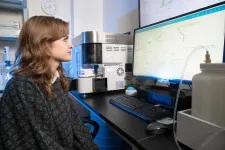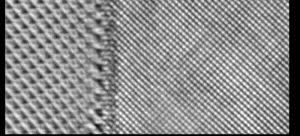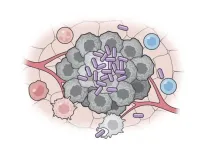(Press-News.org) How can we engineer materials that are stronger and lighter? What about new materials for extreme conditions such as in jet engines and spacecrafts?
The answer, says Fadi Abdeljawad, an associate professor of materials science and engineering in Lehigh University's P.C. Rossin College of Engineering and Applied Science, might be hidden in the infinitesimally tiny regions, or boundaries, where atoms in crystals come together.
Along with his collaborators at the U.S. Department of Energy's Center for Integrated Nanotechnologies (CINT), Abdeljawad is uncovering how those tiny boundaries have such an enormous impact on the characteristics of nanomaterials.
"Atoms come together to form nanocrystals, which are essentially structures about 1/10,000th the width of a human hair," explains Abdeljawad. "Think of these crystals coming together like pieces of a puzzle, or as tiles on a kitchen floor. Billions of these nanocrystals stack on top of each other to form most engineering materials."
According to the researchers, it is the regions where crystals meet that play an outsized role in determining how a material behaves. Recently, the team’s work was published in Nano Letters, a prestigious journal publishing cutting-edge research in nanoscience and nanotechnology that is known for its high impact.
The article, "Triple Junction Segregation Dominates the Stability of Nanocrystalline Alloys," was published July 29, and explores how tiny features in nanomaterials, known as triple junctions, play a crucial role in maintaining the stability of these materials under high temperatures.
Gold in the corners
Nanocrystalline materials have an extremely fine structure, made up of many tiny crystals. This tiny crystal size can make the material stronger. However, keeping these crystals small and stable over time is challenging because they tend to grow, which can weaken the material.
The researchers in this study discovered that the key to maintaining the stability of these materials at high temperatures lies in triple junctions, corners where three of these nanocrystals meet. Imagine the corners of three puzzle pieces coming together.
What the scientists found is that when certain atoms are added to form an alloy, they prefer to occupy sites at these triple junctions. This "chemical segregation" or gathering of atoms at triple junctions helps to keep the grains from growing, thereby preventing the material from losing its strength over time.
This specific study demonstrated that gold atoms carefully placed at triple junctions in a platinum nanomaterial allowed the material to remain stable in conditions of high temperatures.
"By understanding this process," says Abdeljawad, "scientists can design better nanocrystalline alloys. They can choose specific elements that will go to the triple junctions and stabilize the material. This is particularly important for applications where strength and durability at elevated temperatures are key, such as in the aerospace and energy industries."
Drawing on the power of teamwork
Abdeljawad, a computational materials scientist at Lehigh, performed large-scale computational studies that predicted these results. To validate the models, the computational team partnered with the Center for Integrated Nanotechnologies (CINT). CINT provides advanced tools and expertise for nanoscale research, enabling cutting-edge studies in materials science, nanofabrication, and nanophotonics for scientific and technological advancements.
"This is an outstanding example of collaborative science," says Dr. Brad Boyce, a senior scientist at CINT and a co-author on this study. "Our ideas for how to engineer novel materials by tailoring features at the nanoscale are maturing as a result of the ability to simulate the complex arrangement of atoms that make up these materials."
CINT is one of five Nanoscience User Facilities funded by the US Department of Energy Office of Science. It is jointly operated by Sandia National Labs and Los Alamos National Lab, both based in New Mexico. Two facilities, a Core facility in Albuquerque, and a Gateway facility at Los Alamos, offer unique capabilities and expert scientists to advance nanoscience research. These resources are free to user scientists who are accepted based on a peer-reviewed 2-page proposal.
About Fadi Abdeljawad
Fadi Abdeljawad is an associate professor in the Department of Materials Science and Engineering at Lehigh University.
Prior to joining Lehigh, Abdeljawad served as the Bob and Kaye Stanzione Associate Professor in the Department of Mechanical Engineering at Clemson University, with a joint appointment in the Department of Materials Science and Engineering.
He received his MA and PhD with a primary focus on theoretical and computational materials science from Princeton University. Upon completion of his PhD, he joined the Computational Materials and Data Science Department at Sandia National Laboratories first as a postdoctoral fellow, then as a senior member of the technical staff. Prior to his graduate studies, he worked in the aerospace industry, where he was a materials and stress engineer for Sikorsky Aircraft.
In broad terms, Abdeljawad's research group employs cutting-edge computational tools to advance our understanding of how a materials internal structure (i.e., the microstructure) forms during processing treatments and how such microstructures evolve under the application of external fields, i.e., thermal, mechanical, etc. His group complements these computational efforts with machine learning techniques, which provide a low-computational-cost approach to solving microstructure-based problems. His current research is funded by several agencies including the National Science Foundation, Department of Energy, and Department of Defense.
About The Center for Integrated Nanotechnologies
The Center for Integrated Nanotechnologies (CINT) began operations in 2006 and is jointly administered by Los Alamos National Laboratory and Sandia National Laboratories. This Center makes use of a wide range of specialized facilities including the Microsystems and Engineering Sciences Applications at Sandia and the National High Magnetic Field Laboratory at Los Alamos. CINT's vision is to become a world leading resource for developing the scientific principles that govern the design, performance, and integration of nanostructured materials into the micro and macroscale worlds. This differentiating focus on nanomaterials integration involves the experimental and theoretical exploration of behavior over multiple spatial and temporal length scales, the development of novel synthesis and processing approaches, and an understanding of emergent behavior and new performance regime. CINT is an initiative of the U.S. Department of Energy's Office of Science.
END
Innovating in the corners where atoms meet
Lehigh-Sandia-DOE research captures attention from prestigious Nano Letters journal
2024-10-16
ELSE PRESS RELEASES FROM THIS DATE:
Study offers better insights into quality of life for adults with congenital heart disease
2024-10-16
Washington, D.C. (October 16, 2024) – For the first time, adults living with congenital heart disease (CHD) now have valuable insights into their long-term quality of life through data from the Congenital Heart Initiative (CHI). CHI is the nation’s first and largest patient-focused registry for adults with CHD and released its first study involving over 4,500 participants from all 50 states.
This research, published today in JAMA Network Open, marks a significant step forward in making better information available for the ...
Researchers offer alternative to hydroxyurea in study of DNA replication process
2024-10-16
Researchers at Colorado State University have identified an alternate method to study changes during the DNA replication process in lab settings using genetically modified yeast. The new approach offers a clearer window than current drug methods used to understand cell cycle arrest – a fundamental mechanism that is key to treating cancers and genetic issues.
The findings were published in the Proceedings of the National Academy of Sciences and were led at CSU by Assistant Professor Grant Schauer in the Department of Biochemistry and Molecular Biology. The work focuses on hydroxyurea, a chemotherapy drug used ...
New diamond bonding technique a breakthrough for quantum devices
2024-10-16
Synthetic diamond is durable, inert, rigid, thermally conductive and chemically well-behaved—an elite material for both quantum and conventional electronics. But there’s one problem. Diamond only likes diamond.
It’s homoepitaxial, meaning it only grows on other diamonds, and integrating diamond into quantum or conventional computers, quantum sensors, cellphones, or other devices would mean sacrificing the diamond’s full potential or using large, expensive chunks of the precious material.
“Diamond stands alone in terms of its material properties, both for electronics—with its wide band gap, ...
Clean air and climate policies provide health benefits in New York City
2024-10-16
A new study analyzes the links between the enactment of major air pollution and climate policies in New York City and significant improvement in air quality during the period 1998-2021. It finds a cumulative beneficial effect of these policies both city-wide and among residents residing in communities that have been disproportionately affected by air pollution.
The study by environmental health scientists at Columbia University Mailman School of Public Health is published in the peer-reviewed journal Frontiers in Public Health.
“Because of the known significant associations between the pollutants studied and multiple adverse health effects, there are important implications for health ...
Folic acid may mitigate link between lead exposure during pregnancy and autistic behaviours in children
2024-10-16
New research gives another reason to take folic acid supplements while pregnant.
A new study by Simon Fraser University researchers has found that folate may weaken the link between blood-lead levels in pregnant women and autistic-like behaviours in their children.
Researchers from SFU’s Faculty of Health Sciences, led by PhD candidate Joshua Alampi, published the study in the journal Environmental Health Perspectives.
“Folic acid supplementation during pregnancy has numerous benefits to child health, especially brain development,” ...
MD Anderson Research Highlights for October 16, 2024
2024-10-16
HOUSTON ― The University of Texas MD Anderson Cancer Center’s Research Highlights showcases the latest breakthroughs in cancer care, research and prevention. These advances are made possible through seamless collaboration between MD Anderson’s world-leading clinicians and scientists, bringing discoveries from the lab to the clinic and back.
Novel therapeutic target overcomes treatment resistance in triple-negative breast cancer
Many patients with triple-negative breast cancer (TNBC) do not respond to combination ...
STEP Demo pilot plant achieves full operational conditions for Phase 1 of testing
2024-10-16
SAN ANTONIO — October 16, 2024 —The Supercritical Transformational Electric Power (STEP) Demo pilot plant, a $169 million, 10-megawatt supercritical carbon dioxide (sCO2) test facility at Southwest Research Institute (SwRI) in San Antonio, has completed its first phase of testing, having achieved its full operational speed of 27,000 rpm and operating at a target turbine inlet temperature of 500 degrees Celsius. As STEP achieved this milestone, it was synchronized with the electrical grid, generating approximately four megawatts of net power.
“Achieving full operating conditions while connected to the grid is a major advancement ...
Women more likely than men to die after heart surgery complications
2024-10-16
Despite having no greater chance of developing problems after high risk cardiovascular surgery, women are more likely than men to die from postoperative complications, a University of Michigan-led study suggests.
A patient dying of complications after surgery is often referred to as a “failure to rescue”.
Investigators assessed more than 850,000 cases of Medicare beneficiaries who had high risk heart surgery — including heart bypass, aortic aneurysm repair, and mitral and aortic valve repair — ...
Bacterial vaccine shows promise as cancer immunotherapy
2024-10-16
Columbia researchers have engineered probiotic bacteria that educate the immune system to destroy cancer cells, opening the door for a new class of cancer vaccines that take advantage of bacteria’s natural tumor-targeting properties. These microbial cancer vaccines can be personalized to attack each individual’s primary tumor and metastases, and may even prevent future recurrences.
In studies using mouse models of advanced colorectal cancer and melanoma, the bacterial vaccine supercharged the immune system to suppress the growth of – or in many cases eliminate – primary ...
Involuntary sweeps of homeless encampments do not improve public safety, study finds
2024-10-16
AURORA, Colo. (October 16, 2024) – A new study, out today in the Journal of Urban Health, finds that involuntary sweeps of homeless encampments in Denver, Colorado were not effective in reducing crime.
Researchers, led by first author Pranav Padmanabhan, research assistant and MPH student at the University of Colorado Anschutz Medical Campus, analyzed the effect of involuntary displacement on crime in one-quarter to three-quarters of a mile radius around sweep sites, among all sweeps between November ...
LAST 30 PRESS RELEASES:
Air pollution exposure and birth weight
Obstructive sleep apnea risk and mental health conditions among older adults
How talking slows eye movements behind the wheel
The Ceramic Society of Japan’s Oxoate Ceramics Research Association launches new international book project
Heart-brain connection: international study reveals the role of the vagus nerve in keeping the heart young
Researchers identify Rb1 as a predictive biomarker for a new therapeutic strategy in some breast cancers
Survey reveals ethical gaps slowing AI adoption in pediatric surgery
Stimulant ADHD medications work differently than thought
AI overestimates how smart people are, according to HSE economists
HSE researchers create genome-wide map of quadruplexes
Scientists boost cell "powerhouses" to burn more calories
Automatic label checking: The missing step in making reliable medical AI
Low daily alcohol intake linked to 50% heightened mouth cancer risk in India
American Meteorological Society announces Rick Spinrad as 2026 President-Elect
Biomass-based carbon capture spotlighted in newly released global climate webinar recording
Illuminating invisible nano pollutants: advanced bioimaging tracks the full journey of emerging nanoscale contaminants in living systems
How does age affect recovery from spinal cord injury?
Novel AI tool offers prognosis for patients with head and neck cancer
Fathers’ microplastic exposure tied to their children’s metabolic problems
Research validates laboratory model for studying high-grade serous ovarian cancer
SIR 2026 delivers transformative breakthroughs in minimally invasive medicine to improve patient care
Stem Cell Reports most downloaded papers of 2025 highlight the breadth and impact of stem cell research
Oxford-led study estimates NHS spends around 3% of its primary and secondary care budget on the health impacts of heat and cold in England
A researcher’s long quest leads to a smart composite breakthrough
Urban wild bees act as “microbial sensors” of city health.
New study finds where you live affects recovery after a hip fracture
Forecasting the impact of fully automated vehicle adoption on US road traffic injuries
Alcohol-related hospitalizations from 2016 to 2022
Semaglutide and hospitalizations in patients with obesity and established cardiovascular disease
Researchers ‘listen in’ to embryo-mother interactions during implantation using a culture system replicating the womb lining
[Press-News.org] Innovating in the corners where atoms meetLehigh-Sandia-DOE research captures attention from prestigious Nano Letters journal






